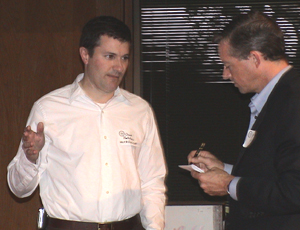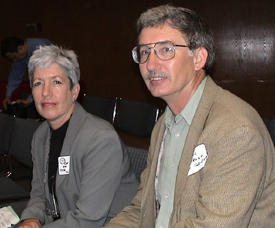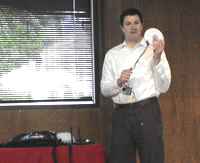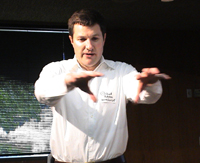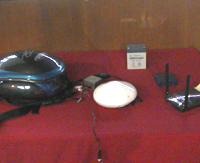David Hutches Describes UCSD Wireless Broadband to SD Telecom Council
|
June 11, 2004 --
In a meeting attended by 50 people last week, David Hutches, associate director of Engineering Computing at UCSD and important technical advisor to Calit², described the philosophy, technical tradeoffs, implementation, applications use, and future plans of wireless infrastructure of UCSD.
The campus is considered widely to be a leader in wireless implementation and integration experiments, and welcomes industrial and academic partners to test the possibilities of wireless capabilities and capabilities for the future.
The forum was the San Diego Telecom Council's Wireless WAN Special Interest Group, which draws those from academia and industry interested in the leading edge.
"UCSD is technologically agnostic," said Hutches, whose unusually comprehensive view of the university's infrastructure is based on a job spanning research to the nuts and bolts of connecting things together. "Our philosophy is to use what works and what's available. Many of our applications were developed implemented on top of 802.11, but the underlying technology is transparent and plays catch up to support the needs of the applications."
One religious issue tends to be the matter of bandwidth vs. ubiquity. "We don't see this as an either/or issue," said Hutches. "And we don't necessarily bow to the altar of high-bandwidth connectivity," which drew laughter from several in the audience. "Rather we pose the question this way: How much is required of either bandwidth or ubiquity, or both, or neither?"
He referred to the classic technology chicken-or-egg problem: Does bandwidth drive demand or vice versa? "Actually, we see it as a chicken-and-egg problem," said Hutches, "because our infrastructure is based on multiple tiers of connectivity, which allow us to bootstrap applications by moving from current to future wireless infrastructure technologies."
|
In the typical hybrid wireless solutions, for the uplink, UCSD draws on a combination of 802.11, 1xRTT, GPRS, and IxEV-DO. For LANs, it draws on 802.11, Bluetooth, IR, and Ethernet. Thus, a common theme in the development of wireless applications at UCSD is both that multiple network technologies work together, and multiple network devices work cooperatively as well.
UCSD's current infrastructure consists mostly of 802.11b with some "a" and "g" deployments and support for cell service (voice and data). Cellular services are a combination of production and commercial systems, as well as experimental ones.
"That's another thing that's very important to us: Working with both production and experimental systems," says Hutches: "We want to know what works. But, we want to experiment with what's coming down the line: How does that work with what already works? Come experiment with us."
Areas of deployment include the Price Center (main student center), roughly half of the dorms, lecture halls, libraries, and high-traffic outdoor areas. The campus has 1,200 official access points and 4,000 registered users (complemented by as many as 700 "private" access points with 1,000 users). Concurrent users number some 350 with peaks of 600.
The network architecture relies on ORiNOCO, Cisco, and Linksys equipment, switched/routed fast and gigabit Ethernet (with extensive use of VLANs), and management provided by Vernier Networks control servers and access managers. In describing the extensive backend infrastructure required to support a reliable, production network, Hutches commented that, "The irony of wireless is that it requires wires."
|
Future plans call for expanding the coverage of 802.11b, improving the performance in higher-density traffic areas, and taking advantage of the capabilities inherent in the "a" and "g" implementations of 802.11.
Hutches described a number of applications making use of the infrastructure. They include a wireless "backpack" that provides mobile 802.11 connectivity, and the CyberShuttle that enables riders to connect to the Internet en route between the Sorrento Valley train station and campus. The latter project's version 1.0 was commercialized by Entrée Wireless and tested in an emergency response drill May 13.
"Now that it's a commercial project, we no longer consider it 'research,'" said Hutches. "It's become infrastructure that we now take for granted. It's a great process."
That's the Calit² mantra: Give us infrastructure, and working with our industrial partners, we'll implement and integrate it, then build on it. We're not interested in standing on our laurels.
Our partners, the technical leaders on campus, industrial partners, and professional associations, like the San Diego Telecom Council, agree with us on this.
A good example of the success of this process: Hutches' team has progressed to v2.0, which enables bidirectional communication with the outside and includes an on-board computer from which to deploy applications, including those that take advantage of video and audio systems also installed on the shuttle. According to Hutches, applications can now be envisioned that would enable cell phone users to poll a shuttle that's a few minutes away to determine if there's room to board, choose music videos to watch while riding, or, after departing, alerting current riders for help in looking for belongings left aboard.
Success with the CyberShuttle led to a spin off: the CyberAmbulance. With the wireless infrastructure of the CyberShuttle and the addition of a video camera, microphone, and VPN technology to ensure a secure channel, an emergency medical technician accompanying the patient in the ambulance can communicate additional information to prepare doctors waiting to receive the patient in the emergency room. This configuration of the CyberShuttle served as a valuable prototype for testing ideas that led to the submission and subsequent awarding of several high-profile research grants involving Calit² researchers at UCSD and UCI.
Two medical applications discussed included StrokeDoc, which supports remote medical video streaming to enable a stroke specialist to diagnose and recommend treatment for a suspected stroke victim in another location, and WIISARD, which is prototyping sophisticated wireless technology to coordinate and enhance patient care in a mass casualty situation caused by a terrorist attack or natural disaster.
Yet another application Hutches discussed was based on remote use of robotic systems to gather information and communicate with people, such as for on-scene investigation of a traffic incident.
"Our initial experiments have been to create components of the infrastructure," concluded Hutches. "Then these components become 'black boxes' that we rely on going forward. They become part of the infrastructure upon which we can fashion new experiments. This progression enables the framework in which we think about problems and their solutions to evolve continually."


